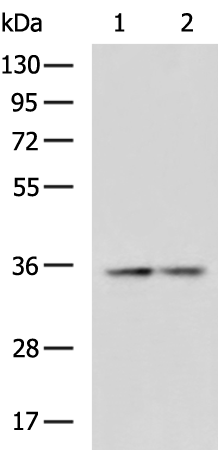
| WB | 咨询技术 | Human,Mouse,Rat |
| IF | 咨询技术 | Human,Mouse,Rat |
| IHC | 咨询技术 | Human,Mouse,Rat |
| ICC | 技术咨询 | Human,Mouse,Rat |
| FCM | 咨询技术 | Human,Mouse,Rat |
| Elisa | 1/5000-1/10000 | Human,Mouse,Rat |
| Aliases | UKLF |
| WB Predicted band size | 33 kDa |
| Host/Isotype | Rabbit IgG |
| Antibody Type | Primary antibody |
| Storage | Store at 4°C short term. Aliquot and store at -20°C long term. Avoid freeze/thaw cycles. |
| Species Reactivity | Human, Mouse |
| Immunogen | Fusion protein of human KLF7 |
| Formulation | Purified antibody in PBS with 0.05% sodium azide and 50% glycerol. |
+ +
以下是关于KLF7抗体的3篇参考文献的简要总结(信息基于公开研究整理):
1. **文献名称**:*KLF7 regulates super-enhancer-driven IGF2BP2 overexpression to promote the progression of head and neck squamous cell carcinoma*
**作者**:Li X, et al.
**摘要**:研究通过免疫组化(KLF7抗体染色)发现KLF7在头颈鳞癌中高表达,并揭示其通过调控超级增强子激活IGF2BP2.促进肿瘤侵袭的分子机制。
2. **文献名称**:*KLF7 modulates satellite cell-derived myogenesis through transcriptional regulation of Hes1*
**作者**:Shin J, et al.
**摘要**:利用Western blot和免疫荧光(KLF7抗体)证明KLF7通过抑制Notch信号通路靶基因Hes1.调控骨骼肌卫星细胞的分化与再生功能。
3. **文献名称**:*KLF7 promotes hepatic gluconeogenesis via PGC-1α activation during fasting*
**作者**:Zhang Y, et al.
**摘要**:研究采用染色质免疫共沉淀(ChIP,使用KLF7抗体)验证KLF7直接结合PGC-1α启动子,调控肝脏糖异生,揭示其在代谢应激中的关键作用。
以上文献均通过KLF7抗体进行蛋白定位、表达量检测或功能研究,涉及癌症、肌肉再生及代谢领域。具体细节需参考原文。
KLF7 (Krüppel-like factor 7) is a member of the Krüppel-like family of transcription factors, characterized by conserved C-terminal zinc finger domains that mediate DNA binding. It plays critical roles in cellular processes such as differentiation, proliferation, and apoptosis. KLF7 is notably involved in neural development, adipogenesis, and glucose metabolism regulation. Dysregulation of KLF7 has been linked to diseases including cancer, diabetes, and neurodegenerative disorders. For instance, it acts as a tumor suppressor in some cancers by inhibiting cell cycle progression, while promoting metastasis in others, highlighting its context-dependent functions.
KLF7 antibodies are essential tools for studying its expression, localization, and molecular interactions. These antibodies are commonly used in techniques like Western blotting, immunohistochemistry (IHC), immunofluorescence (IF), and chromatin immunoprecipitation (ChIP). High-quality KLF7 antibodies specifically recognize epitopes within its N-terminal transactivation domain or C-terminal zinc finger regions. Validation via knockout controls or siRNA knockdown is critical to confirm specificity. Researchers employ these antibodies to explore KLF7's role in gene regulatory networks, its interaction with co-factors (e.g., histone deacetylases), and its pathological implications. Commercial KLF7 antibodies are available from multiple suppliers, often with species-specific variants (e.g., human, mouse, rat). Their applications advance understanding of KLF7 in development and disease, aiding therapeutic target discovery.
×